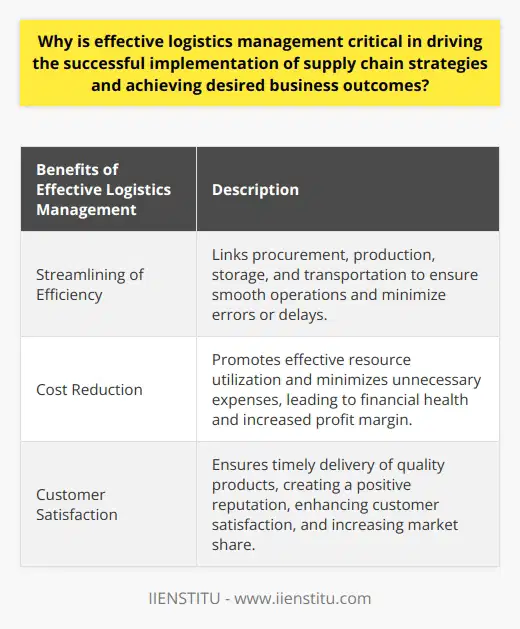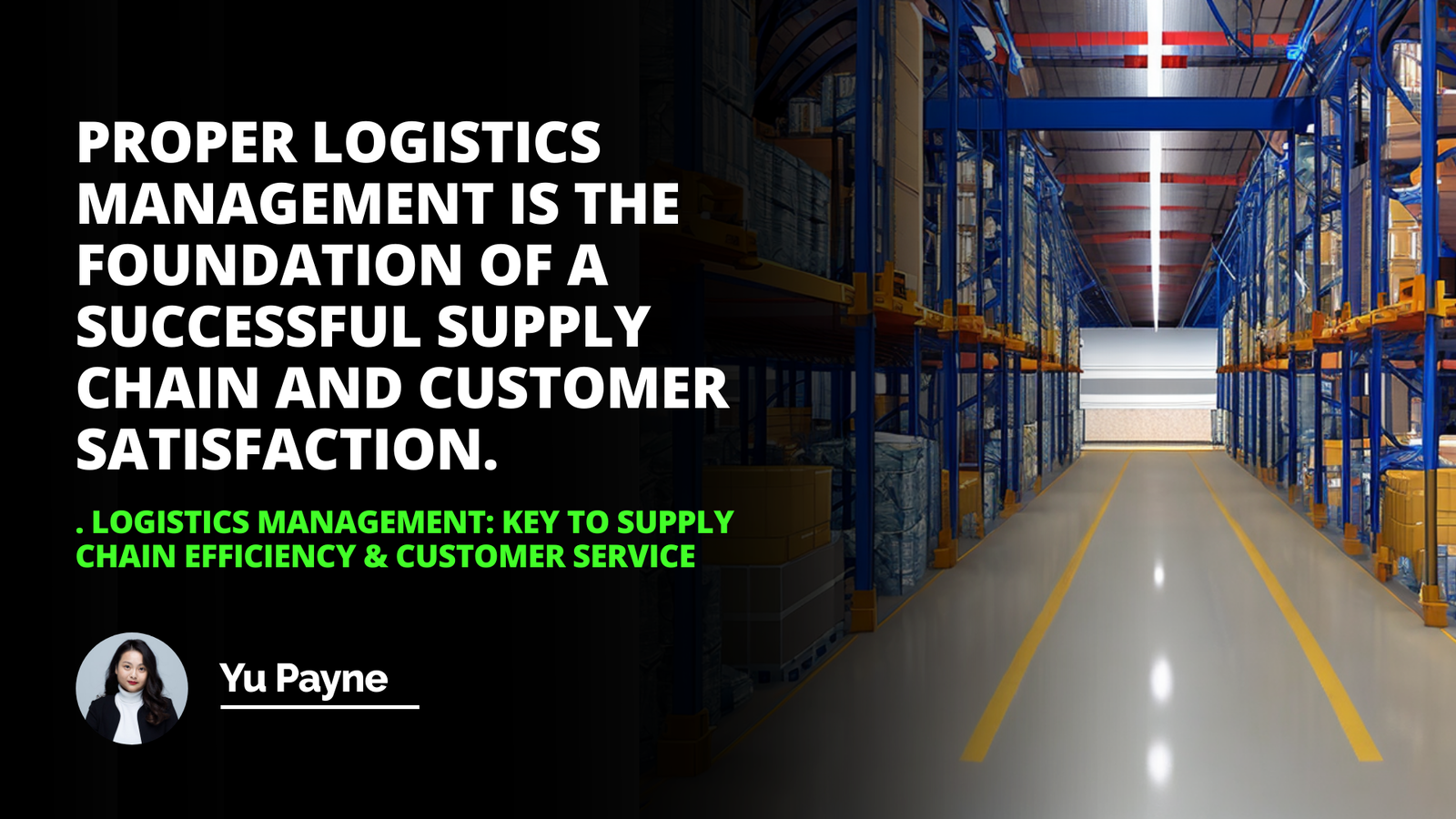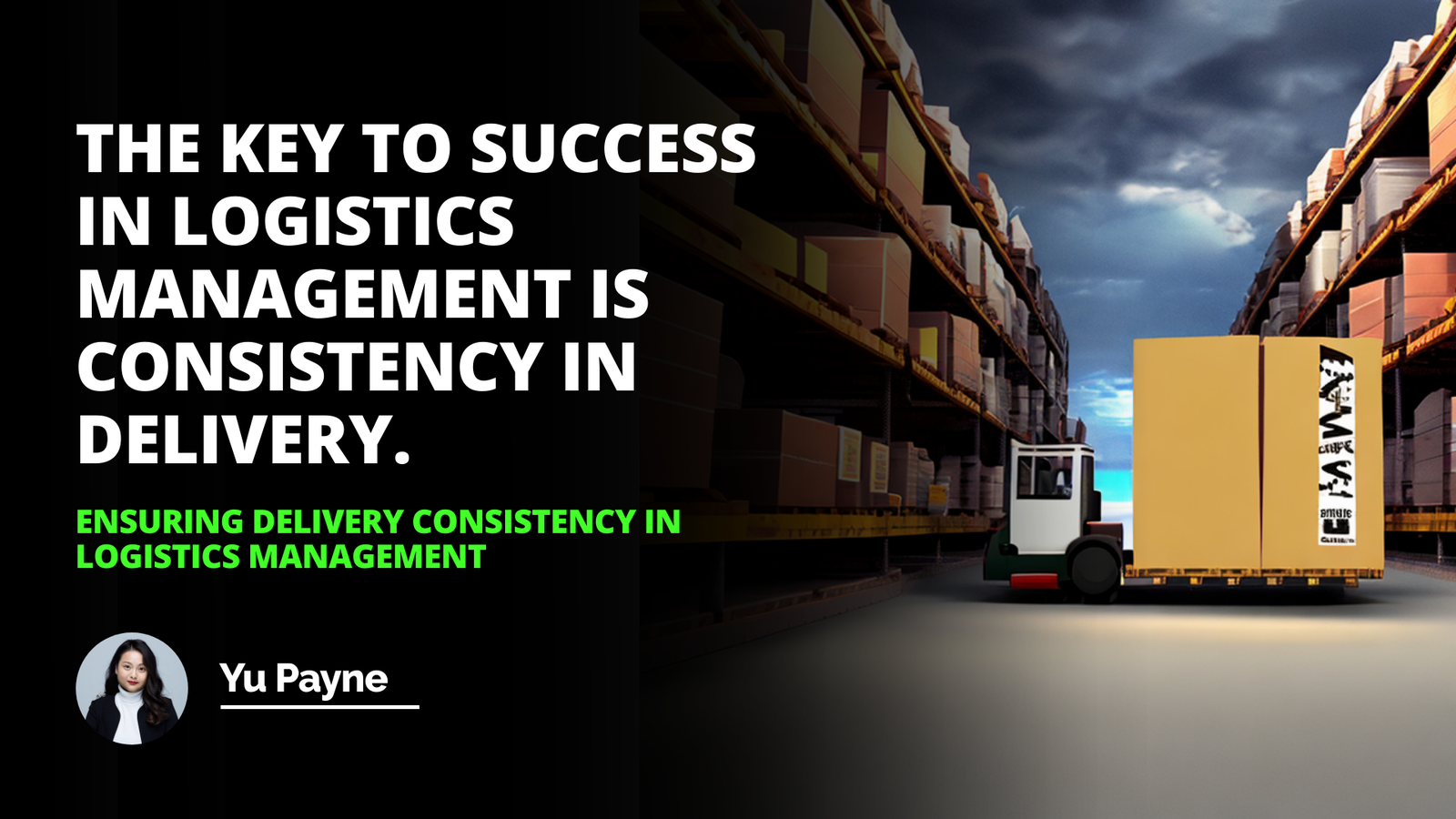
Highlighting the Core Principles of Logistics Solutions
Exploring the Range of Logistics Solutions
Showcasing Success Stories of Companies Utilizing Logistics Solutions
Logistics solutions are an invaluable asset to businesses of all shapes and sizes. This concept refers to processes, services, and activities that help companies optimize the supply chain and internal operations. The ultimate goal of leveraging these solutions is to maximize profits while minimizing the costs associated with production. In addition, the wide range of logistical solutions available to businesses allows for efficiencies across different aspects of operations, allowing companies to improve their performance and become increasingly competitive in the market.
The core idea behind all logistics solutions is accelerating success, which is this blog post's primary focus. We'll explore the various benefits of such solutions, the core principles of these approaches, the wide range of solutions available, and the success stories of companies that have adopted them. In doing so, we will demonstrate to readers how such solutions can be leveraged to drive growth, profitability, and better customer satisfaction.
Principles Of Organization For Effective Management Strategies
İmportance Of Safety Data Sheets İn Operational Safety And Compliance
Highlighting the Core Principles of Logistics Solutions
Logistics solutions are all about streamlining processes and enhancing internal and external connectivity. The goal is to ensure the flow of communication and data, the shipment of goods, and all related services run as smoothly as possible. Streamlining processes and ensuring data is accurate and available promptly allows for faster decision-making and increased efficiency.
On top of streamlining processes and enhancing connectivity, logistics solutions are also effective at reducing costs while improving overall performance. If adequately implemented, companies can often reduce transportation costs and shipping expenses while reducing the time and materials needed to process orders. Ultimately, these savings translate into higher profits and lower fees and are incredibly valuable to any business.
Exploring the Range of Logistics Solutions
The market has a wide range of logistics solutions, each offering different benefits. For example, inventory management solutions help businesses optimize their inventory and replenishment processes, increasing efficiency and reducing costs. Likewise, supply chain management solutions increase efficiencies by assisting firms in streamlining the supply chain and allocating resources more optimally.
Fleet management solutions are another critical component of logistics solutions. These help companies keep track of their vehicle fleets, ensuring that their delivery operations remain efficient and that customers receive their goods promptly. Last-mile delivery services are another essential logistics solution; these are especially important for eCommerce companies as they enable faster deliveries and offer customers a more seamless experience.
Showcasing Success Stories of Companies Utilizing Logistics Solutions
Numerous examples of companies have implemented logistics solutions and achieved success. Walmart, for instance, has leveraged such solutions to improve efficiencies and strengthen its relationships with suppliers. Amazon has also utilized logistics solutions to optimize its supply chain and empower customers with faster, more innovative ordering and delivery options. Finally, UPS has implemented such solutions to track and manage its fleet of delivery trucks more effectively.
Logistics solutions provide businesses with an array of benefits. Such solutions are designed to streamline processes, enhance connectivity, and reduce costs, resulting in more efficient operations and improved customer satisfaction. Logistics solutions also increase the competitiveness of businesses, making them more profitable and allowing them to scale faster. Indeed, this is evidenced by several success stories from companies such as Walmart, Amazon, and UPS that have adopted such solutions and achieved success.
In conclusion, logistics solutions offer businesses many benefits and potential success. With the right approach, companies can find the best solution for their needs and leverage it to accelerate their performance and growth. Furthermore, by taking the time to explore the market correctly and the available logistical solutions, companies can maximize their strategies' potential and create a competitive advantage.
Effectively managing logistics solutions is the key to unlocking the door to success.
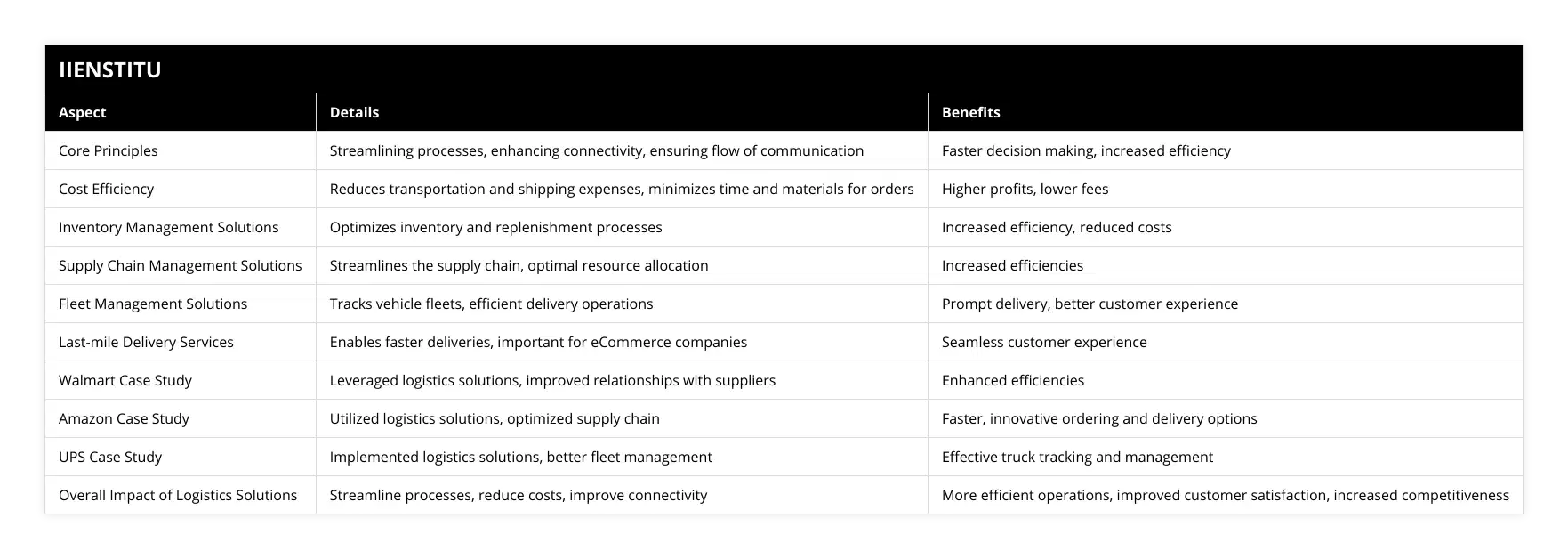
Frequently Asked Questions
What challenges are associated with Accelerating Success Through Logistics Solutions?
The logistics industry is the backbone of many businesses. It is frequently a critical factor in the success of a business venture. However, despite its importance and ubiquity, the sector has unique and continually evolving challenges. When businesses look to increase the efficiency of their delivery and logistics operations, these challenges can become even more apparent.
The primary challenge associated with accelerating success through logistics solutions can be generalized as streamlining short- and long-term operations. An effective logistics strategy covers short-term, day-to-day operations, such as shipment and inventory management, and long-term, strategic planning. A successful long-term process will often involve complex network planning and capacity optimization. At the same time, short-term objectives usually focus on time and cost-sensitive demands. To effectively manage the entire logistic process, businesses must integrate multiple systems and processes, including customer relationships, demand management, and intermodal transport management.
The ability to effectively coordinate disparate functions often presents numerous challenges. For instance, different teams may be working to achieve similar goals, and conflicting approaches can result in operational inefficiencies. Additionally, a lack of centralized data management can impede the ability to recognize, assess and address customer demands promptly. Furthermore, an inability to access key metrics and performance indicators could lead to delays in delivery, resulting in a frustrating user experience.
To successfully address these challenges, businesses must be able to survey their current operations and develop a comprehensive, customized solution. This solution should include a clear strategy guide and standardized processes, including performance measurement and quality assurance. Aside from streamlining processes, such a solution would require businesses to make well-informed decisions regarding their technology selection, including software applications and analytics platforms.
In conclusion, accelerating success through logistics solutions requires businesses to go beyond simply hiring a dedicated team or implementing a new system. The demands and complexities of the logistics industry require businesses to continuously improve their methods and optimize operations. Companies can create customized solutions to keep them ahead of competitors through appropriate metrics, data management, and the right technology.
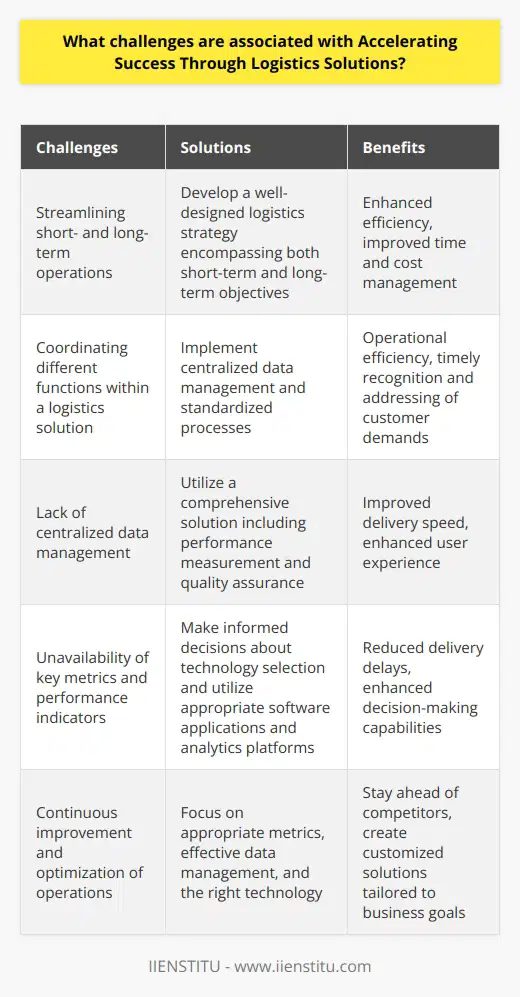
How can Accelerating Success Through Logistics Solutions increase efficiency in a supply chain?
When businesses seek to optimize supply chain efficiency, the most effective approach involves strategic opportunities for accelerating success through logistics solutions. Having control over the entire supply chain process, from end to end, is necessary to fulfill customer needs promptly and cost-effectively. Logistics solutions allow businesses to capitalize on analytical tools, such as dynamic time clustering, to modify the routing and scheduling of products and optimally manage inventory levels. Furthermore, these solutions address freight transportation, warehousing, and other factors that influence the economics of supply chains.
Precise tracking and visibility of shipments are core elements of logistics solutions. Instead of relying on manual processes to plan, optimize, and assess the supply chain process, these solutions automate tasks and update the variance in the supply chain to maintain efficiency. This ensures that businesses will not experience delays and deal with unexpected situations more quickly.
Another key element of logistics solutions is automation and optimization. Businesses can centralize supply chain optimization by utilizing algorithms and powerful analytical software. The software can simulate and predict the most efficient and cost-effective options. Increasing a company's ability to respond to customer needs can improve efficiency by reducing the time it takes to reconstruct or reorganize the supply chain to accommodate unexpected changes or demands. Additionally, this technology can be used to improve the utilization of the fleet and maximize the loading of shipment trucks. This reduces transit times and frees up resources for handling and transporting more shipments.
Overall, leveraging modern logistics solutions to accelerate success within the supply chain process dramatically improves efficiency. By monitoring, regulating, and optimizing processes, such solutions present many advantages resulting in improved customer satisfaction and cost-effectiveness. In addition, by deploying state-of-the-art analytics and automation technologies, businesses will experience greater control over the supply chain process, enabling them to adapt more quickly to market demands and ultimately remain competitive.
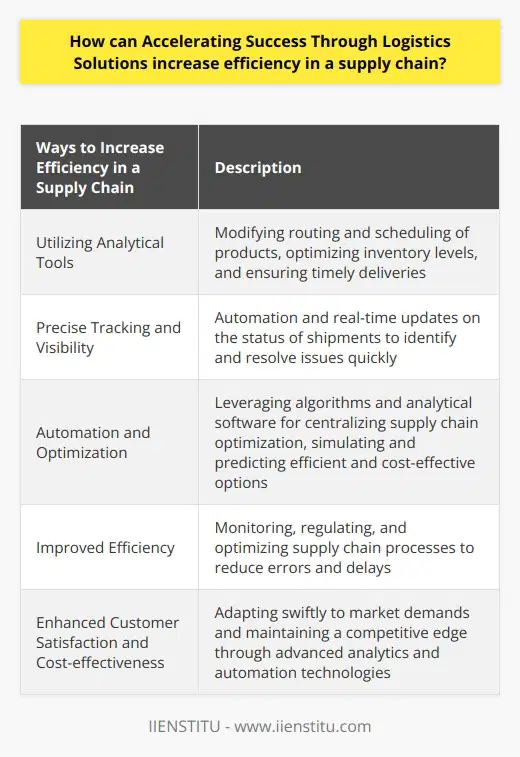
What strategies can be leveraged to optimize performance in Accelerating Success Through Logistics Solutions?
Logistics solutions are becoming increasingly important in the modern business environment and can provide the foundation for successful businesses. Using efficient logistics solutions can reduce costs and improve customer service, making them an effective tool for achieving business success. However, proper management and optimization of these solutions are essential if they can be leveraged as an accelerant for success. This article will examine strategies that can be used to optimize performance when integrating logistics solutions into an organization.
First and foremost, organizations must understand their current operational processes and the functionalities of the logistics solutions they intend to implement. Logistics solutions involve a variety of technologies and procedures that must be integrated to be effective, and a comprehensive assessment of current operations will help identify any changes that need to be made before implementation. Additionally, organizations should evaluate the potential impact of performance on existing infrastructure and systems and their ability to accommodate the change.
The next step is to develop an action plan for integrating logistics solutions into the organization. A successful action plan should be designed to ensure data accuracy and provide real-time visibility into operations. The program should incorporate the functionalities of the logistics solutions and provide clear instructions on utilizing the technologies best. Additionally, the plan should include system set-up and training guidelines, as well as measures to troubleshoot and monitor the impact of the implementations.
Organizations should also consider leveraging artificial intelligence (AI) and machine learning (ML) to optimize performance. AI and ML can be used to analyze data as it is collected and appropriately make system changes. This function can help improve accuracy and streamline operations, enabling organizations to get the most out of their logistics solutions. Additionally, predictive analytics can be used to anticipate customer needs and provide recommendations on better meeting those needs.
Finally, organizations should consider using analytics and reporting to measure the performance of the implemented logistics solutions. Tools such as dashboards, which can be used to measure key performance indicators (KPIs) and identify areas for improvement, can help ensure that the solutions are effectively meeting the organization’s goals. In addition, reporting should be used to evaluate the impact of implementations so that changes can be made as necessary.
Overall, using logistics solutions can be an effective tool for accelerating success. Organizations can optimize their implementations for maximum performance by leveraging the abovementioned strategies. Ultimately, this can provide a foundation for achieving tremendous business success.
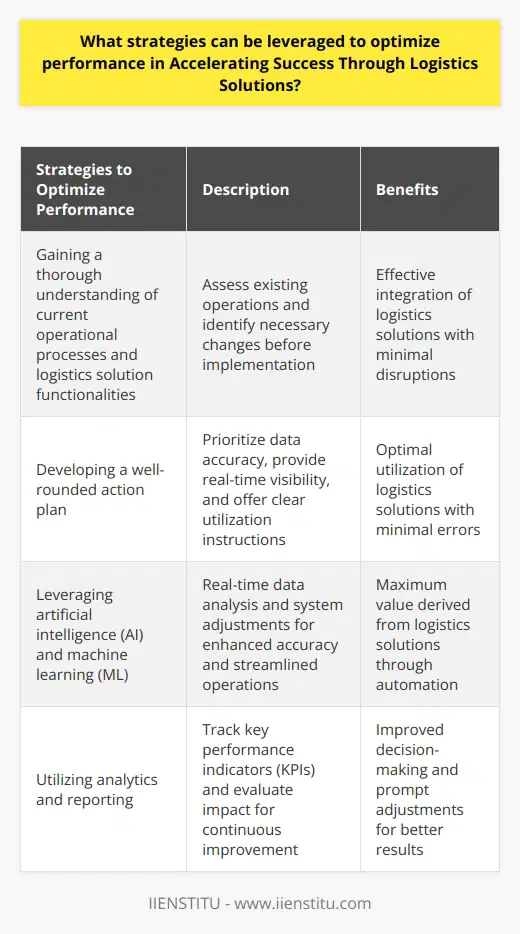
What are the primary components of an effective logistics strategy?
Components of an Effective Logistics Strategy
Strategic Planning and Alignment
The first component of an effective logistics strategy is the alignment of the logistics plan with the organization's overall strategic objectives. This ensures that logistics activities contribute to achieving business goals, such as enhancing customer service or reducing operational costs.
Network Optimization
Another essential component is network optimization, which involves designing and managing the distribution channels and transportation networks efficiently. Through network optimization, organizations can minimize transportation and handling costs, reduce lead time, and improve service levels for their customers.
Inventory Management
Effective inventory management is a critical aspect of logistics strategy as it impacts the cost of holding and managing stock, product availability, and customer service levels. Proper inventory control techniques, including demand forecasting and inventory level optimization, can help organizations reduce excess stock, prevent stock-outs, and decrease costs.
Transportation and Carrier Management
An effective logistics strategy should also encompass transportation and carrier management, aiming to reduce transportation costs and ensure efficient and reliable shipment of goods. This approach includes selecting the appropriate mode of transport, negotiating favorable rates with carriers, and monitoring carrier performance.
Information Sharing and Visibility
Open collaboration and communication among all stakeholders in the supply chain is vital for effective logistics strategy implementation. Sharing relevant information across the supply chain, such as demand forecasts, production plans, and inventory levels, can lead to better decisions, reduced lead times, and improved overall efficiency.
Technology Integration
Incorporating technology into logistics strategy plays a significant role in enhancing efficiency, visibility, and responsiveness in the supply chain. Implementing technologies, such as warehouse management systems, transportation management systems, and supply chain visibility platforms, can facilitate data-driven decision-making and improve process automation and agility.
Sustainability and Risk Management
Finally, an effective logistics strategy should consider the impact of logistics activities on the environment and prioritize sustainability initiatives. This includes adopting green logistics practices, such as reducing energy consumption or selecting eco-friendly transportation modes. Additionally, proactive risk management strategies should be established to ensure that supply chain disruptions are promptly identified and mitigated.
In conclusion, an effective logistics strategy comprises several critical components to ensure operational efficiency, cost reduction, superior customer service, and sustainability. By focusing on strategic alignment, network optimization, inventory management, transportation and carrier management, information sharing, technology integration, and risk management, organizations can develop and execute a successful logistics strategy that supports their overall business objectives.

How does rapid response in logistics contribute to supply chain resilience and competitiveness?
Rapid Response in Logistics
Supply chain resilience and competitiveness are increasingly important in today's globalized economy. Rapid response in logistics plays a crucial role in enhancing both these aspects by enabling companies to adapt swiftly and efficiently to dynamic market conditions.
Supply Chain Resilience through Quick Adaptation
A key attribute of a resilient supply chain is its ability to recover quickly from disruptions and return to normal operations. This is where rapid response logistics comes into play. By implementing agile distribution strategies, companies can minimize the impact of unforeseen events, such as natural disasters, political upheavals, or sudden changes in demand. This is achieved through advanced planning, real-time monitoring, and effective communication, which allows organizations to swiftly adjust their logistic operations as needed.
Improved Competitiveness through Speed and Efficiency
In addition to promoting supply chain resilience, rapid response logistics encourages competitiveness by offering significant advantages over slower, traditional methods. For one, rapid response enables businesses to cut lead times and deliver products faster, which ultimately results in increased customer satisfaction. Furthermore, by adopting advanced technologies and streamlined processes, companies can reduce costs and improve the overall efficiency of their supply chains, gaining a competitive edge in the market.
Dealing with Market Volatility
Another area where rapid response in logistics plays a significant role is in managing the uncertainties and fluctuations inherent in the global market. Flexibility in logistics allows companies to respond quickly to changing market conditions, minimizing the impact on both suppliers and customers. This agile approach reduces the risk of inventory obsolescence, stockouts, and overstock situations. Companies that prioritize rapid response are positioned better to adapt to customer needs and emerging trends, effectively navigating market volatility.
Sustained Growth and Innovation
Lastly, by investing in rapid response logistics, companies can drive their growth and innovation. This is because a flexible and responsive supply chain facilitates the development and launch of new products, enabling businesses to capitalize on emerging opportunities. Moreover, by maintaining a resilient supply chain, organizations can confidently invest in research and development, knowing that their logistics infrastructure can support their growth objectives.
In conclusion, rapid response in logistics directly contributes to supply chain resilience and competitiveness by allowing companies to adapt quickly to disruptions, improve operational efficiency, and capitalize on new opportunities. In a world characterized by constant change and increasing complexity, prioritizing rapid response is no longer an option but a necessity for businesses that wish to thrive in the long term.
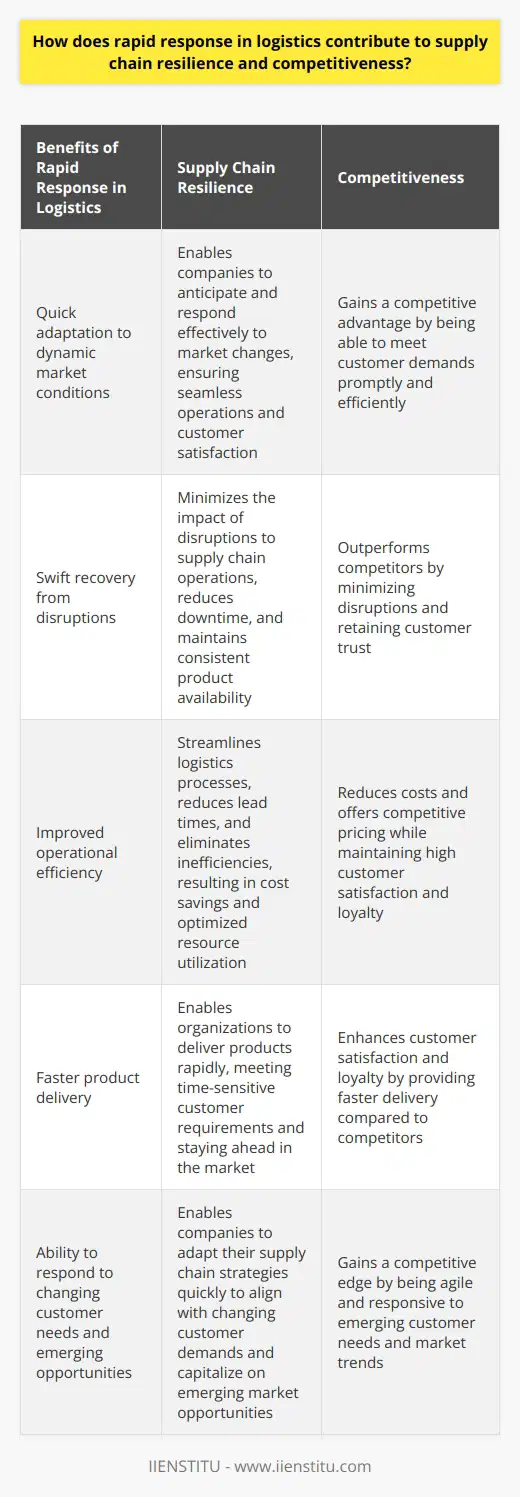
In what ways does efficient logistics management lead to overall business growth and improved customer satisfaction?
Enhanced Operational Productivity
Efficient logistics management contributes to enhancing operational productivity by optimizing the supply chain and reducing operating costs. By managing inventory levels strategically, businesses can minimize storage costs and effectively utilize warehouse space. Through technological integration and automation, logistics management can streamline processes and enable better decision-making, thereby improving the overall efficiency of the organization.
Increased Profit Margins
One of the significant ways logistics management bolsters overall business growth is by allowing for increased profit margins. By improving supply chain operations, businesses can reduce their expenses, such as transportation and labor costs. This directly leads to higher profits, enabling organizations to allocate more resources to other growth-driving initiatives, such as research and development, marketing, and talent acquisition.
Improved Customer Satisfaction
Efficient logistics management leads to improved customer satisfaction in several ways, such as reduced delivery times, accurate order fulfillment, and effective communication throughout the order process. These factors play a vital role in meeting customer expectations and enhancing their overall experience with the company. Businesses that prioritize customer satisfaction often see improved customer retention rates, which, in turn, can lead to increased revenue and business growth.
Competitive Advantage
In today's global economy, businesses that excel in logistics management can achieve a competitive advantage over their rivals. By optimizing supply chain operations, companies can respond quickly to changes in market demands and customer preferences. Efficient logistics management also enables businesses to consistently maintain high-quality standards for their products and services. This greatly contributes to establishing a positive brand reputation and attracting new customers.
Adaptability to Market Changes
The ever-evolving nature of the market demands that businesses remain adaptable in order to sustain growth. Efficient logistics management is essential in ensuring a business can effectively respond to changes in consumer demands, industry trends, and economic conditions. By constantly monitoring and analyzing the supply chain, logistics managers can quickly identify potential issues and implement corrective measures, thereby minimizing disruption to the business and ensuring continued growth.
In conclusion, efficient logistics management plays a fundamental role in promoting business growth and improving customer satisfaction. Enhanced operational productivity, increased profit margins, competitive advantage, and adaptability to market changes are some of the key benefits of efficient logistics management. By employing effective strategies and adopting technology-driven solutions, businesses can optimize their supply chain operations, meeting the needs of their customers and driving overall organizational success.
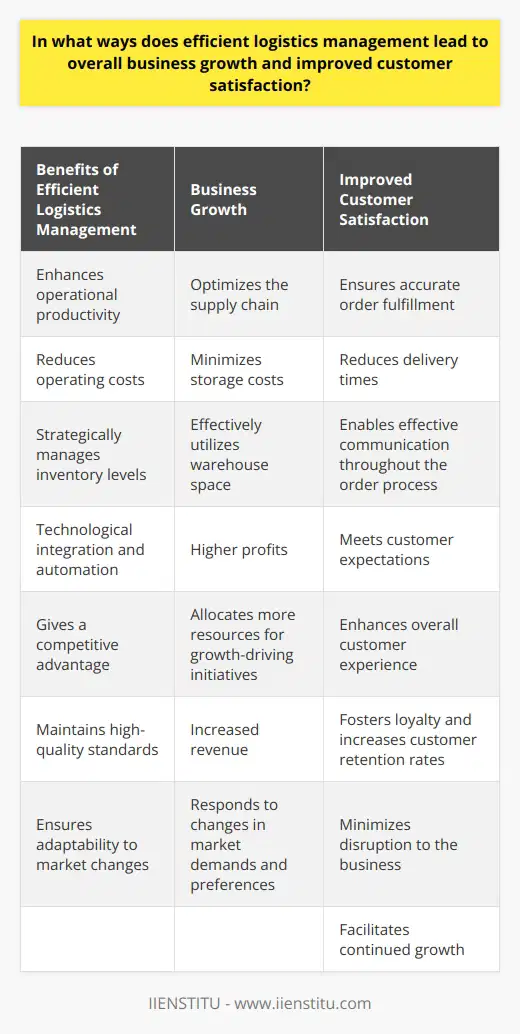
What are the 5 logistics strategies?
Five Key Logistics Strategies
Supply Chain Network Design
One essential logistics strategy is the effective design of a supply chain network. This involves determining the optimal locations of distribution centers, warehouses, and transportation hubs, and also entails evaluating the most efficient routes to deliver goods to end consumers. Proper network design helps businesses minimize costs, increase efficiency, and improve customer satisfaction.
Inventory Management
Inventory management is crucial for ensuring the smooth flow of goods through a supply chain. This strategy involves maintaining accurate records of stock levels and product turnover, as well as determining the appropriate stock levels to meet customer demand. Efficient inventory management helps organizations avoid stockouts, reduce inventory holding costs, and maintain optimal product availability.
Transportation Management
Effective transportation management involves selecting the most appropriate transportation modes and carriers, consolidating shipments, and negotiating favorable rates with transport providers. This strategy is vital for minimizing costs, enhancing shipment visibility, and improving overall supply chain efficiency.
Cross Docking
A fourth key logistics strategy is cross docking, a process in which products are transferred directly from inbound containers to outbound containers, bypassing the need for long-term storage in warehouses. This approach reduces handling and storage costs, minimizes product transit times, and improves overall supply chain efficiency.
Collaboration and Integration
Collaboration and integration are essential strategies for coordinating the various components of a supply chain, such as suppliers, manufacturers, carriers, and retailers. By fostering close relationships and effective communication with these partners, businesses can attain increased visibility into supply chain operations, streamline processes, and achieve more accurate demand forecasting. Ultimately, collaboration and integration strategies promote a more efficient, responsive, and cost-effective supply chain.
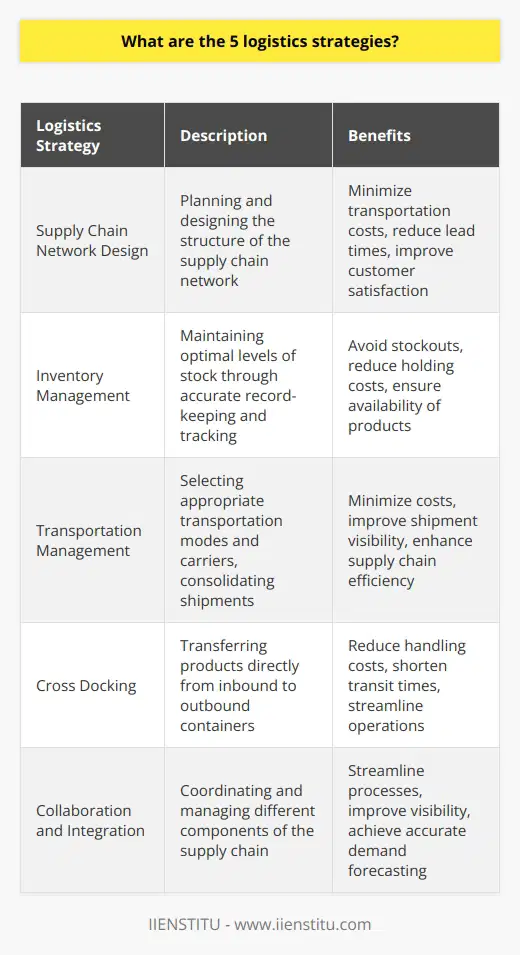
What are the 3 logistics objectives?
Logistics Objectives Overview
The three primary logistics objectives are cost reduction, customer satisfaction, and flexibility. These objectives reflect a company's commitment to efficient supply chain management that generates higher profits and ensures its long-term survival.
Cost Reduction
Reducing costs is a primary goal for any business, as it directly affects profit. By optimizing logistics operations, companies can effectively minimize expenses associated with purchasing, transportation, warehousing, and order fulfillment. To achieve this, businesses must regularly analyze their supply chain processes, identify inefficiencies, and implement improvements based on data-driven decision-making.
Customer Satisfaction
Customer satisfaction plays a vital role in maintaining a company's competitive advantage, as it fosters customer loyalty and encourages repeat business. Ensuring the prompt and accurate delivery of goods is an essential logistics objective, fulfilled through efficient order processing, responsive inventory management, and the establishment of close partnerships with carriers. By focusing on meeting customer expectations concerning product availability, lead times, and delivery accuracy, companies can build long-lasting relationships and enhance their overall market position.
Flexibility
In today's rapidly changing global market, the ability to adapt to evolving customer demands and unexpected disruptions is crucial for businesses. An effective logistics strategy must incorporate a certain degree of flexibility to accommodate changes in product requirements, fluctuating demand, and disruptions in the supply chain, such as supplier delays or transportation issues. By focusing on improving adaptability, companies can ensure their logistics operations can react swiftly to market shifts, enabling them to maintain their competitive edge and protect their bottom line.
In conclusion, cost reduction, customer satisfaction, and flexibility are the three logistics objectives that businesses must strive to achieve for effective supply chain management. By implementing streamlined processes, adapting to market changes, and prioritizing customer needs, companies can excel in the competitive landscape and secure their long-term success.
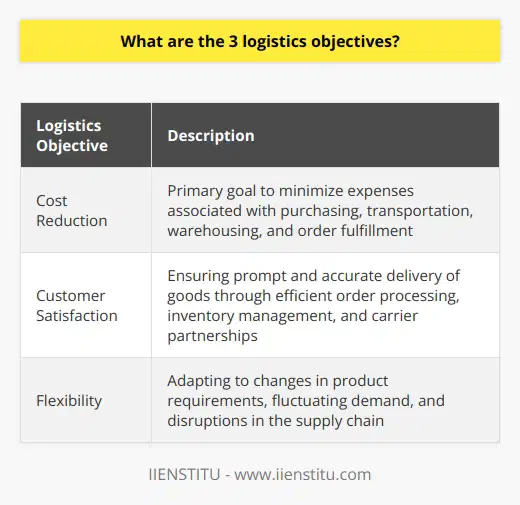
What is rapid response in logistics?
Rapid Response in Logistics
Definition and Components
Rapid response in logistics involves the swift, efficient, and effective management of supply chain operations in order to address urgent or unexpected demands or crises. This approach is essential for businesses to remain competitive and ensure customer satisfaction. The main elements of rapid response include demand forecasting, inventory management, transport optimization, and communication and coordination.
Demand Forecasting
Demand forecasting is the process of predicting future consumer demand to make informed decisions about supply chain management. Accurate demand forecasts enable businesses to respond quickly to market dynamics, adjusting production and distribution plans accordingly.
Inventory Management
Inventory management refers to the process of maintaining an adequate supply of goods to meet expected demand while minimizing storage and carrying costs. In a rapid response context, this means having sufficient inventory on hand while quickly mobilizing and redistributing resources as needs arise.
Transport Optimization
Transport optimization is the process of choosing the most efficient and cost-effective methods of transporting goods from suppliers to customers. This is crucial in rapid response logistics as it ensures prompt delivery without sacrificing quality or incurring excessive expenses.
Communication and Coordination
Effective communication and coordination between all supply chain stakeholders, including suppliers, manufacturers, transportation providers, and customers, are crucial for the successful implementation of rapid response logistics. This ensures that all parties work collaboratively to address emerging challenges, optimize resources, and maintain overall efficiency.
Benefits of Rapid Response
Adopting a rapid response approach in logistics offers several advantages, including reduced lead times, improved customer satisfaction, increased competitiveness, and enhanced flexibility. These benefits result from the ability to quickly adapt to changing market conditions, accurately forecast demand, and effectively manage inventory and transportation resources. Additionally, effective communication and coordination between parties ensure seamless operations and timely delivery of goods.
In conclusion, rapid response logistics is a vital aspect of modern supply chain management, enabling businesses to address sudden changes in demand and cope with unforeseen challenges. By focusing on demand forecasting, inventory management, transport optimization, and effective communication and coordination, companies can better serve their customers and maintain a competitive edge in the market.

What makes logistics successful in ensuring the smooth flow of goods and services within a supply chain?
Effective Planning
Successful logistics in a supply chain largely depend on effective planning. This aspect entails the precise mapping of how goods and services will move from one point to another.
Understanding Customer Demand
Understanding customer demand is also crucial. Logistics can respond promptly and efficiently to fluctuations in demand when they understand the patterns.
Efficient Transportation
Efficient transportation of goods is a vital component. The choice of transport can significantly impact the smoothness of the supply chain process.
Optimizing Inventory
Inventory optimization also contributes to a robust logistics system. Efficient inventory management ensures goods are available when needed, averting any possible disruption in the supply chain.
Coordination and Collaboration
Logistics success is impossible without coordination and collaboration between all parties involved in the supply chain. Cooperation enables seamless execution of all logistics processes, from procurement to delivery.
Leveraging Technology
The use of technological tools enhances logistics effectiveness. Technology can automate various logistics processes, making them more accurate and efficient.
In conclusion, planning, understanding demand, efficient transportation, inventory optimization, coordination, collaboration, and technology are paramount for the success of logistics in supply chain management. These elements work together to ensure a smooth flow of goods and services, minimizing disruptions and maximizing efficiency.
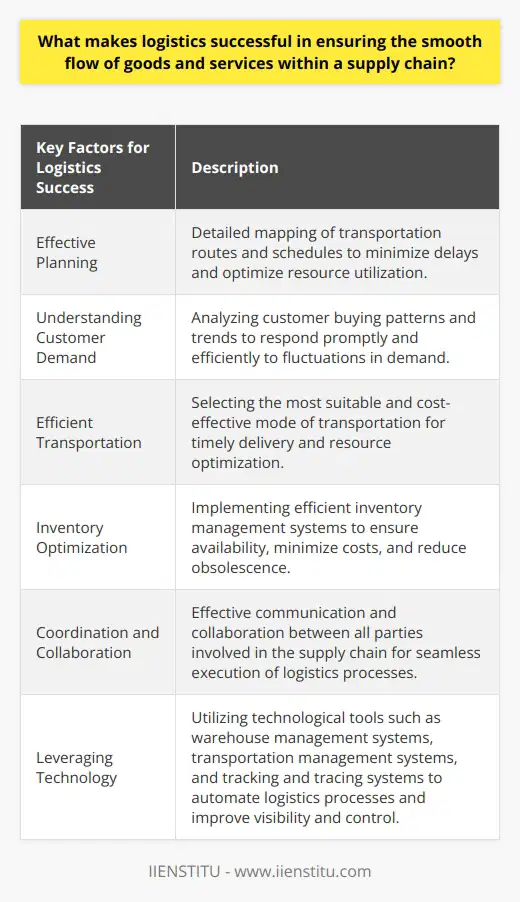
How can innovative logistics solutions contribute to improved product quality and customer satisfaction?
Innovative Logistics and Product Quality
Innovative logistics solutions can significantly enhance product quality. Advanced tracking systems, for instance, enable real-time monitoring of the product throughout its lifecycle. It helps identify issues directly affecting the product quality like climate control, shock, and vibration during transportation. Therefore, immediate corrective measures help retain the product quality.
Cutting-edge logistics technologies, such as automated warehousing and robotic picking, reduce human errors. By limiting the scope for manual errors, these solutions uphold the quality of products dispatched to customers. Hence, high-quality products lead to increased customer satisfaction.
Integrated Logistics Solutions and Customer Satisfaction
The utilization of integrated logistics solutions also contributes to improved customer satisfaction. Delivery speed is a crucial factor in customer satisfaction. Implementing solutions like drone delivery or optimized routing can expedite product delivery, leading to happier customers. Moreover, automated systems often enhance delivery accuracy by properly managing dispatch and delivery timings.
On another note, investing in sophisticated logistics management software entrusts companies with improved forecasting and inventory planning abilities. This implies that there will be fewer instances of stockouts and overstocks. Consequently, customers experience the convenience of always finding the products they seek - yet another significant boost to customer satisfaction.
Transparent and efficient return management systems, facilitated by innovative logistics, further contribute to customer satisfaction. These systems simplify return procedures, reducing customer hassle and boosting their trust in the business. In conclusion, employing innovative logistics solutions is a strategic approach to promote product quality and customer satisfaction.
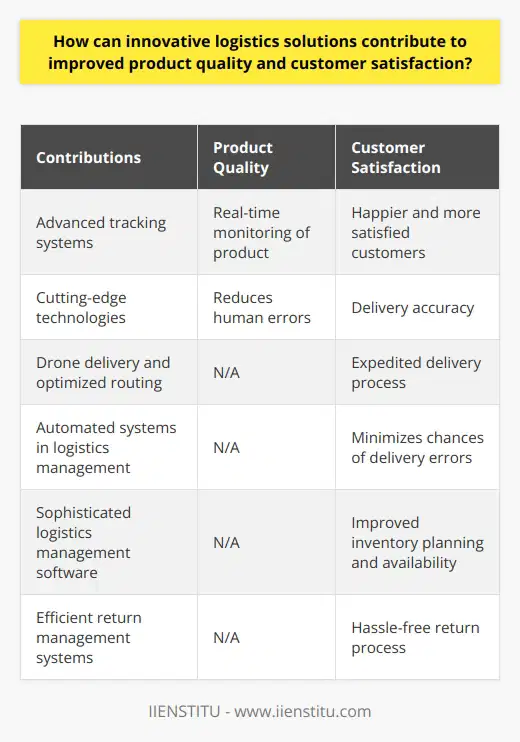
Why is effective logistics management critical in driving the successful implementation of supply chain strategies and achieving desired business outcomes?
Effective Logistics Management and Business Outcomes
In the commercial landscape, effective logistics management stands as a critical factor in implementing supply chain strategies successfully. It stands as a determinant of business success. The reason lies in how logistics management ensures the efficient movement and storage of goods from the point of origin to the point of consumption.
Streamlining Efficiency
Efficient logistics management enables streamlined operations. It reduces the chances of errors or delays, which significantly contribute to achieving desired business outcomes. It connects all the dots in a supply chain, linking procurement, production, storage, and transportation.
Reducing Costs
Well-executed logistics management also leads to cost reduction. It promotes effective utilization of resources and avoids wastage. Less waste translates into less cost, thereby increasing the profit margin. This cost-effectiveness contributes to the financial health of a business.
Maintaining Customer Satisfaction
A focal point of logistics management is to meet customer expectations. Timely delivery of quality products satisfies customers, leading to customer retention and loyalty. Hence, effective logistics management aids in creating a positive reputation, which can increase a business's market share.
In conclusion, effective logistics management plays a pivotal role in driving the successful implementation of supply chain strategies. Its ability to streamline operations, reduce costs, and maintain high customer satisfaction contributes to achieving desired business outcomes. Therefore, businesses should focus on fine-tuning their logistics management processes for better results.
